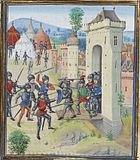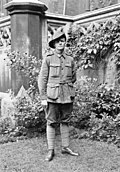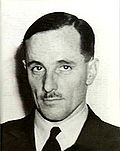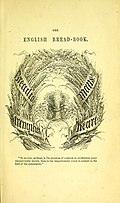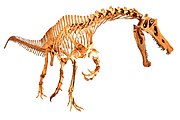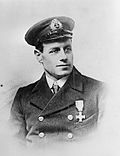Wikipedia:Today's featured article/April 2019
| << | Today's featured articles for April 2019 | >> | ||||
|---|---|---|---|---|---|---|
| Su | Mo | Tu | We | Th | Fr | Sa |
| 1 | 2 | 3 | 4 | 5 | 6 | |
| 7 | 8 | 9 | 10 | 11 | 12 | 13 |
| 14 | 15 | 16 | 17 | 18 | 19 | 20 |
| 21 | 22 | 23 | 24 | 25 | 26 | 27 |
| 28 | 29 | 30 | ||||
April 1
The Siege of Aiguillon commenced on 1 April 1346 during the Hundred Years' War, when a French army commanded by John, Duke of Normandy, laid siege to the Gascon town of Aiguillon. The town, with strategic command of the rivers Garonne and Lot, was defended by Anglo-Gascon forces under Ralph, Earl of Stafford. The garrison, some 900 men, sortied repeatedly to interrupt the French operations, while Henry, Earl of Lancaster, concentrated the main Anglo-Gascon force at La Réole as a threat. Duke John, the son and heir of Philip VI, was never able to fully blockade the town. By August, the seriously harassed French supply lines had broken down, there was a dysentery epidemic in their camp, desertion was rife, and Philip was demanding that John's force join up with the main French army. On 20 August the French abandoned the siege and marched away. Six days later Philip's army was decisively beaten by the main English army in the Battle of Crécy, two weeks before John's force arrived in the north. (Full article...)
April 2
Jørgen Jensen (1891–1922) was a Danish-born Australian recipient of the Victoria Cross, the highest award for gallantry in battle that could be awarded to a member of the Australian armed forces at that time. Jensen enlisted in the Australian Imperial Force in March 1915, serving with the 10th Battalion during the latter stages of the Gallipoli Campaign. After the Australian force withdrew to Egypt, he was transferred to the newly formed 50th Battalion, and sailed for France with the unit in June 1916. On the Western Front, he was wounded during the battalion's first serious action, the Battle of Mouquet Farm in August, and only returned to his unit in late January 1917. On 2 April, his battalion attacked the Hindenburg Outpost Line at Noreuil, where his actions led to the capture of over fifty German soldiers and resulted in the award of the Victoria Cross. Jensen survived the war, despite a severe head wound in April 1918, but died in 1922. (Full article...)
April 3
The killdeer (Charadrius vociferus) is a large plover found in the Americas. It was described and given its current scientific name in 1758 by Carl Linnaeus in the 10th edition of his Systema Naturae. Subspecies breed from southeastern Alaska and southern Canada to Mexico, in the West Indies, and in and around Peru. The non-breeding habitat includes coastal wetlands, beach habitats, and coastal fields. Although it is a shorebird, it does not necessarily nest close to water. Both parents incubate their eggs for 22 to 28 days on average. The killdeer primarily feeds on insects, although other invertebrates and seeds are eaten. It forages almost exclusively in fields, especially those with short vegetation and with cattle and standing water. It has a range of responses to predation by birds and mammals, including charging at intruders, which can be fatal for the killdeer. The species is declining but not yet threatened. (Full article...)
April 4
Roberto Luongo (born April 4, 1979) is a professional ice hockey goaltender from Canada. Employing the butterfly style, he plays for the Florida Panthers of the National Hockey League and previously played for the NHL's New York Islanders and Vancouver Canucks. Luongo is a two-time NHL Second All-Star (2004 and 2007) and a winner of the William M. Jennings Trophy for backstopping his team to the lowest goals against average in the league (2011). He has been a finalist for the Vezina Trophy as the league's best goaltender (2004, 2007 and 2011), the Lester B. Pearson Award as the top player voted by his peers (2004 and 2007) and the Hart Memorial Trophy as the league's most valuable player (2007). Luongo is second all-time in games played as an NHL goaltender, and is third all-time in wins. He was named to the 2014 Canadian Olympic Hockey Team, where he won his second Olympic gold medal in a largely backup role to Carey Price. (Full article...)
April 5
Live and Let Die is the second novel in Ian Fleming's James Bond series. Set in London, the US and Jamaica, it was first published in the UK by Jonathan Cape on 5 April 1954. Fleming wrote the novel at his Goldeneye estate in Jamaica before his first book, Casino Royale, was published. The story centres on Bond's pursuit of Mr Big, who has links to an American criminal network, the world of voodoo and SMERSH—an arm of the Russian secret service—all of which are threats to the West. Bond becomes involved in the US through Mr Big's smuggling of 17th-century gold coins from British territories in the Caribbean. The novel deals with themes of the ongoing East–West struggle of the Cold War, including British and American relations, Britain's position in the world, race relations and the struggle between good and evil. It was adapted in 1973 as the eighth film in the Eon Productions Bond series and the first to star Roger Moore as Bond. (Full article...)
April 6
The Rogožarski IK-3 was a 1930s Yugoslav monoplane single-seat fighter, designed as a successor to the Ikarus IK-2 fighter. Coming into service in 1940, it was considered comparable to foreign aircraft such as the Messerschmitt Bf 109E. Although the prototype crashed during testing, a total of twelve production aircraft had been delivered by July 1940. Six IK-3s were serviceable when the Axis invasion of Yugoslavia began on 6 April 1941. All six were in service with the 51st Independent Fighter Group at Zemun near Belgrade. Pilots flying the IK-3 claimed 11 aircraft shot down during the 11-day conflict. According to one account, to prevent them from falling into German hands, the surviving aircraft and incomplete airframes were destroyed by their crews and factory staff. Another account suggests that one aircraft survived the invasion and was later destroyed by sabotage. The IK-3 design was the basis for the post-war Yugoslav-built Ikarus S-49 fighter. (Full article...)
April 7
Sabre Wulf is an action-adventure game by Ultimate Play the Game, initially released in 1984 for the ZX Spectrum home computer. The player navigates the pith-helmeted Sabreman through a colourful 2D jungle maze to collect amulet pieces, avoid enemies, and bypass the guardian at its exit. With no explicit guidance on how to play, the player is left to decipher the game's objectives through trial and error. The game developers had finished Sabre Wulf's sequels in advance of its release but—in keeping with their penchant for secrecy—chose to withhold them until later that year. They hired outside developers to port the game to several other computing platforms. Sabre Wulf was a bestseller and a financial success. It was recommended by reviewers, who also noted its difficult gameplay and praised its graphics. Retrospective critics remember Sabre Wulf as among the Spectrum's best releases. (Full article...)
April 8
Billy Martin (1928–1989) was an American Major League Baseball second baseman and the on-again, off-again manager of the New York Yankees. Known first as a scrappy infielder on the championship Yankee teams of the 1950s, he built a reputation as a manager who would initially make bad teams good, and then be fired amid dysfunction. In each of his stints with the Yankees, he led them to winning records before being fired or forced to resign by team owner George Steinbrenner. Martin led the team to consecutive American League pennants in 1976 and 1977; they lost in the 1976 World Series but triumphed over the Los Angeles Dodgers in 1977, Martin's only World Series championship as a manager. He was forced to resign midway through the 1978 season, returned in 1979, and was fired at season's end. From 1980 to 1982, he managed the Oakland A's, earning a division title with an aggressive style of play known as "Billyball". After the A's fired him, he managed the Yankees three more times. (Full article...)
April 9
Planet Nine is a hypothetical planet in the outer region of the Solar System. Its gravitational effects could explain the unlikely clustering of orbits for a group of extreme trans-Neptunian objects, bodies with average distances from the Sun that are more than 250 times that of Earth. These objects tend to make their closest approaches to the Sun in one sector, and their orbits are similarly tilted. Their improbable alignments suggest that an undiscovered planet may be shepherding the orbits of the most distant known Solar System objects. Planet Nine would have a predicted mass five to ten times that of Earth, and an elongated orbit extending 400 to 800 times as far from the Sun as the Earth's. It may have been ejected from its original orbit by Jupiter during the genesis of the Solar System, wrested from another star, captured as a rogue planet, or pulled into an eccentric orbit by a passing star. (Full article...)
April 10
The Fall of Kampala was a battle during the Uganda–Tanzania War in April 1979, in which the combined forces of Tanzania and the Uganda National Liberation Front (UNLF) attacked and captured the Ugandan capital, Kampala. Tanzanian forces were repulsing an invasion launched by Ugandan President Idi Amin (pictured). After routing the Ugandans and their Libyan allies in Entebbe, the Tanzanians moved on Kampala. They entered the city with UNLF forces on 10 April, facing minimal resistance but hampered by their lack of maps. The fall of the city was announced the next day. The Tanzanians cleared out the remaining pockets of opposition, while jubilant civilians celebrated through indiscriminate, destructive looting. Amin was deposed, his forces were scattered, and a new government was installed. The battle marked the first time in the modern history of the continent that an African state seized the capital of another African country and deposed its government. (Full article...)
April 11
Satellite Science Fiction was an American science fiction magazine, published from October 1956 to April 1959 by Leo Margulies' Renown Publications. It was edited initially by Sam Merwin, then Margulies, and finally Frank Belknap Long. In addition to a handful of short stories, initially each issue ran a full-length novel, including the original version of Philip K. Dick's first novel The Cosmic Puppets, and well-received work by Algis Budrys and Jack Vance, though the quality was not always high. Isaac Asimov, Arthur C. Clarke, and L. Sprague de Camp were among the short story contributors. Sam Moskowitz wrote a series of articles on the early history of science fiction for Satellite; these were later to be revised as part of his book Explorers of the Infinite. In 1958 Margulies tracked down the first magazine publication of H.G. Wells' The Time Machine from 1894–1895, and reprinted a short excerpt from it that had been omitted by every subsequent printing. (Full article...)
April 12
Allison Guyot is an undersea volcanic mountain with a flat top in the Mid-Pacific Mountains. West of Hawaii and northeast of the Marshall Islands, it rises 1,500 metres (4,900 ft) above the seafloor to a platform 35 by 70 kilometres (22 mi × 43 mi) wide. It was probably formed by a hotspot before plate tectonics moved it north to its present-day location. Radiometric dating puts the formation of a volcanic island at around 111 to 85 million years ago. The island was eventually buried, forming an atoll-like structure and a carbonate platform. The platform emerged above sea level at some time in the Albian or Turonian ages before eventually drowning about 99 million years ago for unknown reasons; it is possible that the emergence damaged its reefs. After a hiatus lasting until the Paleocene, pelagic sedimentation deposited limestone, ooze and sand, which bear traces of climatic events and ocean currents. (Full article...)
April 13
Joe Hewitt (13 April 1901 – 1 November 1985) rose to be an air vice-marshal in the Royal Australian Air Force (RAAF). Appointed the RAAF's Assistant Chief of the Air Staff in 1941, he was posted the following year to Allied Air Forces Headquarters, South West Pacific Area, as Director of Intelligence. In 1943, he took command of No. 9 Operational Group, the RAAF's main mobile strike force, but was controversially sacked by the Chief of the Air Staff, Air Vice Marshal George Jones, less than a year later over alleged morale and disciplinary issues. As Air Member for Personnel from 1945 to 1948, he was directly responsible for the consolidation of what was then the world's fourth largest air force into a much smaller peacetime service. He was appointed a Commander of the Order of the British Empire in 1951. Retiring from the military in 1956, he went into business and later managed his own publishing house. The book Adversity in Success is his first-hand account of the South West Pacific air war. (Full article...)
April 14
Tottenham Hotspur F.C. have a long history as an English football club based in Tottenham, London. They came into existence in 1882, became professional in 1895, and in 1901 became the only non-League club to win the FA Cup since the establishment of the Football League. They have won the FA Cup a further seven times, the Football League twice, the League Cup four times, the UEFA Cup twice and, in 1963, the UEFA Cup Winners' Cup. In 1960–61, they became the first team to complete The Double in the 20th century. The club languished mostly in the Second Division from the late 1920s until the 1950s before peaking in the 1960s, with a resurgence in the 1980s. They have remained a member of the Premier League since its formation in 1992, finishing in mid-table most seasons. In 1899 the club moved from Northumberland Park to a site that became known as White Hart Lane, and remained there until 2017. A new stadium has been built at the same site. (Full article...)
April 15
The Cadaver Tomb of René of Chalon is a Gothic funerary monument in the church of Saint-Étienne at Bar-le-Duc in northeastern France. It consists of an altarpiece and a limestone statue of a putrefied and skinless corpse which stands upright; its left arm is raised as if gesturing towards heaven. Completed sometime between 1544 and 1557, the majority of its construction is attributed to the French sculptor Ligier Richier. Other elements, including the coat of arms and funeral drapery, were added later. The tomb dates from a period of societal anxiety over death, as plague, war and religious conflicts ravaged Europe. It was commissioned as the resting place of René of Chalon, Prince of Orange, son-in-law of Duke Antoine of Lorraine. Unusually for contemporary objects of this type, the skeleton is standing, making it a "living corpse", an innovation that was to become highly influential. It was designated a Monument historique on June 18, 1898. (Full article...)
April 16
Courbet was the lead ship of her class of four dreadnought battleships, the first ones built for the French Navy. In World War I, after helping to sink the Austro-Hungarian protected cruiser SMS Zenta in August 1914, she provided cover for the Otranto Barrage that blockaded the Austro-Hungarian Navy in the Adriatic Sea, and often served as a flagship. Although upgraded several times before World War II, by the 1930s she was no longer considered to be a first-line battleship and spent much of that decade as a gunnery training ship. A few weeks after the German invasion of France on 10 May 1940, Courbet was hastily reactivated. She supported Allied troops in the defence of Cherbourg during mid-June. As part of Operation Catapult, she was seized in Portsmouth by British forces on 3 July and was turned over to the Free French a week later. She was used as a stationary anti-aircraft battery and as an accommodation ship there. (Full article...)
April 17
Eliza Acton (17 April 1799 – 13 February 1859) was an English food writer and poet. In 1845 her cookbook Modern Cookery for Private Families was released. It was one of Britain's first cookbooks aimed at the domestic reader and introduced the now-universal practice of listing ingredients and giving suggested cooking times for each recipe. It included the first recipes in English for Brussels sprouts and for spaghetti. Engagingly written, the book was well received by reviewers. It was reprinted within the year and several editions followed until 1918. In the later years of its publication, Modern Cookery was eclipsed by the success of Isabella Beeton's bestselling Mrs Beeton's Book of Household Management (1861), which included several recipes plagiarised from Acton's work. Many English cooks have been influenced by Acton, including Elizabeth David, Jane Grigson, Delia Smith and Rick Stein. (Full article...)
April 18
Sissinghurst Castle Garden, at Sissinghurst in the Weald of Kent in England, was created by Vita Sackville-West, poet and writer, and her husband Harold Nicolson, author and diplomat. Designated Grade I on Historic England's register of historic parks and gardens, it had nearly 200,000 visitors in 2017. It was bought by Sackville-West in 1930, and over the next thirty years, working with, and later succeeded by, a series of notable head gardeners, she and Nicolson transformed a farmstead of "squalor and slovenly disorder" into one of the world's most influential gardens. The garden design is based on axial walks that open onto enclosed gardens, termed "garden rooms", one of the earliest examples of this gardening style. Following Sackville-West's death in 1962, the estate was gifted to the National Trust for Places of Historic Interest or Natural Beauty. It is one of the Trust's most popular properties. (Full article...)
April 19
Irritator was a spinosaurid dinosaur that lived in what is now Brazil about 110 million years ago, during the Early Cretaceous. It is known from a nearly complete skull found in the Romualdo Formation of the Araripe Basin. The genus name reflects the irritation of paleontologists who found that the skull had been heavily damaged and altered by collectors. Estimated at between 6 and 8 meters (20 and 26 ft) in length, Irritator weighed around 1 tonne (1.1 short tons), making it one of the smallest spinosaurids known. Its long, shallow and slender snout was lined with straight and unserrated conical teeth. Lengthwise atop the head ran a thin sagittal crest, to which powerful neck muscles were likely anchored. A generalist diet—like that of today's crocodilians—has been suggested. Irritator inhabited the tropical environment of a coastal lagoon surrounded by dry regions. It coexisted with other carnivorous theropods as well as turtles, crocodyliforms, and a large number of pterosaur and fish species. (Full article...)
April 20
King's Highway 420 is a 400-series highway in the Canadian province of Ontario that connects the Queen Elizabeth Way (QEW) with downtown Niagara Falls. The roadway continues east as the limited-access expressway Niagara Regional Road 420, which was transferred to the jurisdiction of the Regional Municipality of Niagara in 1998; it connects with the Rainbow Bridge at the border with the United States over the Niagara River. King's Highway 420 has a speed limit of 80 kilometres per hour (50 mph), making it the only 400-series highway to have a speed limit less than 100 kilometres per hour (62 mph) for its entirety. Originally constructed as a divided four-lane road with two traffic circles, the route of Highway 420 formed part of the QEW between 1941 and 1972. It was assigned a unique route number during its reconstruction as a freeway and the construction of the large interchange at its western terminus at Montrose Road. (Full article...)
April 21
Gothic boxwood miniatures are very small religious wood sculptures produced during the 15th and 16th centuries, mostly in today's Low Countries. They were formed from intricate layers of reliefs often rendered at nearly microscopic levels, with around 150 examples extant today. The majority are spherical beads known as prayer nuts, statuettes, skulls, or coffins; some 20 are in the form of polyptychs including triptych and diptych altarpieces, tabernacles, and monstrances. Typical imagery includes scenes from the Crucifixion of Jesus and extensive vistas of Heaven and Hell. Each miniature required exceptional craftsmanship and may have taken decades to complete. A number of the miniatures may have come from a workshop led by Adam Dircksz, who is thought to have produced dozens of them. Almost nothing is known about him or the artisans who produced them. Important collections are in the Art Gallery of Ontario, the British Museum, and at the Metropolitan Museum of Art in New York. (Full article...)
April 22
The Lynchburg Sesquicentennial half dollar was a commemorative half dollar designed by Charles Keck and struck by the United States Bureau of the Mint in 1936, to celebrate the 150th anniversary of the incorporation of Lynchburg, Virginia. The obverse of the coin depicts former Secretary of the Treasury and U.S. Senator Carter Glass, a native of Lynchburg. The reverse depicts a statue of the goddess Liberty, her arms outstretched in welcome. In the background is the Old Lynchburg Courthouse and the city's Confederate monument. After Congress authorized the half dollar, the Commission of Fine Arts proposed that it should bear the portrait of John Lynch, founder of Lynchburg, instead of Glass, but no portrait of him was known. Glass became the third living person to appear on a U.S. coin, and the first to be shown alone. Issued for $1, the coins have appreciated over the years, with 2018 estimates of value ranging between $225 and $365. (Full article...)
April 23
Marjorie Cameron (April 23, 1922 – June 24, 1995) was an American artist, poet, actress, and occultist. After serving in the navy during the Second World War, she settled in Pasadena, California. There she met the rocket pioneer Jack Parsons, whom she married in 1946. After Parsons' death in an explosion at their home in 1952, Cameron came to suspect that her husband had been assassinated, and began rituals to communicate with his spirit. She was part of the avant-garde artistic community of Los Angeles; among her friends were the filmmakers Curtis Harrington and Kenneth Anger. She appeared in two of Harrington's films, The Wormwood Star and Night Tide, as well as in Anger's film Inauguration of the Pleasure Dome. In later years, she made appearances in art-house films created by John Chamberlain and Chick Strand. Cameron's recognition as an artist increased after her death, and her paintings were shown in exhibitions across the country. (Full article...)
April 24
Æthelberht was the King of Wessex from 860 until his death in 865. He was the third son of King Æthelwulf by his first wife, Osburh. In 855 Æthelwulf went on pilgrimage to Rome and appointed Æthelberht as king of the recently conquered territory of Kent. Æthelberht's older brother, Æthelbald, was named king of Wessex. After the deaths of his father in 858 and his brother in 860, Æthelberht ruled both Wessex and Kent without appointing a sub-king, fully uniting the two territories for the first time. According to the Anglo-Saxon Chronicle, he reigned "in good harmony and in great peace". He appears to have been on good terms with his younger brothers, the future kings Æthelred I and Alfred the Great. The kingdom came under attack from Viking raids during his reign, but these were minor compared to the invasions after his death. Æthelberht died in the autumn of 865 and was buried next to his brother Æthelbald at Sherborne Abbey in Dorset. He was succeeded by Æthelred. (Full article...)
April 25
Alodia was a medieval Nubian kingdom in what is now central and southern Sudan. Its capital was Soba, near modern-day Khartoum at the confluence of the Blue and White Nile rivers. In 580 it became a part of the Christian world, following the other two Nubian kingdoms, Nobadia and Makuria. Alodia reached its peak during the 9th–12th centuries, when it exceeded its northern neighbor and close ally, Makuria, in size, military power and economic prosperity. A large, multicultural state, Alodia was ruled by a powerful king and provincial governors appointed by him. Soba was a prosperous town and trading hub, and literacy in Nubian and Greek flourished. Goods arrived from Makuria, the Middle East, western Africa, India and even China. Alodia began a slow decline in the 12th century, possibly because of invasions from the south, droughts and a shift of trade routes, before finally collapsing around 1500. (Full article...)
April 26
The Benty Grange helmet is a boar-crested Anglo-Saxon helmet from the 7th century. It was excavated by Thomas Bateman in 1848 from a burial mound at the Benty Grange farm in Monyash in western Derbyshire. The grave had probably been looted by the time of Bateman's excavation, but still contained other high-status objects suggestive of a richly furnished burial, such as the fragmentary remains of a hanging bowl. The ornate helmet was constructed by covering the outside of an iron framework with plates of horn and the inside with cloth or leather, now decayed. It would have provided some protection against weapons, but may have also been intended for ceremonial use. It was the first Anglo-Saxon helmet to be discovered; others have been found at Sutton Hoo, York, Wollaston, Shorwell, and Staffordshire. The helmet is displayed at Sheffield's Weston Park Museum, which purchased it from Bateman's estate in 1893. (Full article...)
April 27
Teresa Sampsonia (1589–1668) was a noblewoman of the Safavid Empire of Iran. She was born into a noble Orthodox Christian Circassian family and grew up in Isfahan in the Iranian royal court. In 1608 she married the Elizabethan English adventurer Robert Shirley, who attended the Safavid court in an effort to forge an alliance against the neighbouring Ottoman Empire. She accompanied him on the Persian embassy to Europe (1609–15), where he represented the Safavid king Abbas the Great. She was received by many of the royal houses of Europe, including the English prince Henry Frederick and Queen Anne, who were her son's godparents. The historian Thomas Herbert considered Robert Shirley "the greatest Traveller of his time", but admired the "undaunted Lady Teresa" even more. Following the death of her husband from dysentery in 1628, she left Iran and lived in a convent in Rome for the rest of her life. (Full article...)
April 28
Skipper Thomas Crisp (28 April 1876 – 15 August 1917) was a posthumous recipient of the Victoria Cross. A commercial fisherman operating from Lowestoft in Suffolk, England, Crisp joined the Royal Navy in 1915. He was killed in the North Sea defending his armed naval vessel, His Majesty's Smack Nelson, against an attack from a German submarine. The government used his self-sacrifice against long odds to bolster morale in the First World War during a difficult time for Britain, the summer and autumn of 1917, when the country was suffering heavy losses in the Battle of Passchendaele. His exploit was read aloud by David Lloyd George in the House of Commons and made headline news for nearly a week. After the war, a small display in his memory was set up in a Lowestoft library with parts of the sunken Nelson, which were dredged up years later, and a specially commissioned painting. This display was destroyed during the Second World War when the building was gutted in the Blitz. (Full article...)
April 29
Jeremy Thorpe (29 April 1929 – 4 December 2014) was a British politician who served as Member of Parliament for North Devon from 1959 to 1979, and as leader of the Liberal Party between 1967 and 1976. After graduating from Oxford University, he became one of the Liberals' brightest stars in the 1950s. As party leader, Thorpe capitalised on the growing unpopularity of the Conservative and Labour parties to lead the Liberals through a period of electoral success. This culminated in the general election of February 1974, when the party won 6 million votes. In May 1979 he was tried at the Old Bailey on charges of conspiracy and incitement to murder, arising from an earlier relationship with Norman Scott, a former model. Thorpe was acquitted on all charges, but the case, and the scandal, ended his political career. By the time of his death he was honoured for his record as an internationalist, a supporter of human rights, and an opponent of apartheid and all forms of racism. (Full article...)
April 30
Pittas (Pittidae) are a family of birds found in Asia, Australasia and Africa. There are numerous species in three genera, Pitta, Erythropitta and Hydrornis, all similar in general appearance and habits. They are Old World suboscines, closely related to the broadbills. Pittas are medium-sized by passerine standards, at 15 to 25 cm (5.9–9.8 in) in length, and stocky, with strong, longish legs and long feet. They have very short tails and stout, slightly decurved bills. Many have brightly coloured plumage. Most pitta species are tropical, although a few species can be found in temperate climates. They are mostly found in forests, but some live in scrub and mangroves. They usually forage alone on wet forest floors in areas with good ground cover. They eat earthworms, snails, insects and similar invertebrate prey, as well as small vertebrates. The main threat to pittas is habitat loss in the form of rapid deforestation; they are also targeted by the cage-bird trade. (Full article...)

